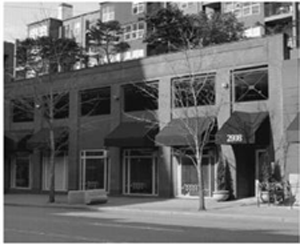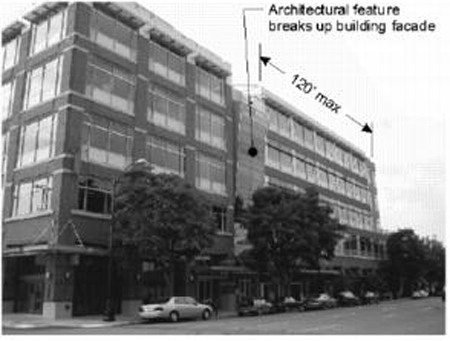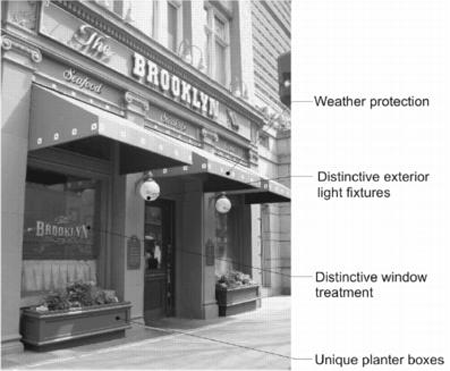21.62.030 Overlake Village Zones Supplemental Design Standards.
A. Purpose. The purpose of this section is to implement the vision for Overlake Village set forth in the Redmond Comprehensive Plan by providing supplemental design standards that will guide development to achieve that vision.
B. Applicability. All projects within Overlake Village shall adhere to the standards in RZC 21.60, Citywide Design Standards, as well as the supplemental design standards identified below. If the Citywide and Overlake standards conflict, the Overlake standards shall prevail.
C. Surface Parking Lots.
1. Intent. To limit the visual impact of surface parking lots.
2. Design Criteria.
a. Location.
i. No new surface parking lots are permitted along 152nd Avenue NE or 156th Avenue NE. Any surface parking lots shall be separated from these streets by a building or at least 60 feet of open space.
ii. On other streets in Overlake Village, new surface parking lots located between the primary building and the public right-of-way are discouraged and may not occupy more than 50 percent of the lot frontage.
b. Landscaping and Screening. Where permitted, interior parking lot landscaping should incorporate the use of rain gardens to retain and infiltrate runoff from the parking lot.
D. Parking Garage Design.
1. Intent. To reduce the visual impact of structured parking located above grade.
2. Design Criteria.
a. Ground level street frontage shall not be occupied by parking in the following locations:
i. 152nd Avenue NE or 156th Avenue NE.
ii. Streets that are included as part of the urban pathway system as shown on Map 12.1, Overlake Village Subarea Map.
b. In other locations, no more than 120 feet of ground level building frontage may be occupied by parking. Parking structures wider than 120 feet must incorporate other uses along the street front to meet this requirement.
c. Where the garage wall is built to the sidewalk edge, the facade shall include treatments to enhance the pedestrian environment and obscure the view of parked cars, such as artwork, decorative grilles, and special building material treatment/design. In order to meet transparency requirements, garages should incorporate openings with grillwork or other treatments to resemble windows.
d. Small setbacks with terraced landscaping elements should be used to soften the appearance of a parking garage.
e. Upper level parking garages shall use articulation, treatments that resemble windows, or other devices to break up the massing of the garage, add visual interest, and convey an appearance more like a typical building floor rather than a floor of visible cars.
|
Figure 21.62.030A |
|---|

|
E. Building Form and Scale.
1. Intent. To maintain light and views, reduce the bulk of taller buildings, reinforce pedestrian scale on street frontages, and promote variety in building height.
2. Design Criteria.
a. Light for Residential Buildings and Courtyards.
i. Throughout Overlake Village, residential or residential/mixed-use buildings over six stories in height shall be designed to provide and maintain adequate natural light for residential dwellings of the building.
ii. Enclosed courtyards shall not be permitted for structures over six stories in height, except when:
A. Floors seven and higher do not exceed 50 percent of the structure’s floor plate; or
B. The courtyard, due to its size and orientation, is designed to allow natural light to light all areas of the courtyard during various times of the day, such that no area of the courtyard is perpetually in shadow during all daylight hours.
iii. The interior courtyard for U- or H-shaped buildings shall be separated from the sidewalk to create a private area, provided that the enclosure is constructed of transparent building material.
b. Building Step Back and Height Limit.
i. Along 152nd Avenue NE, the upper stories of buildings over six stories in height shall be stepped back from the street to maintain a pedestrian scale along the street frontage.
ii. The step back shall be a minimum of 10 feet wide, measured from the building edge at the street frontage. The step back shall begin by floor seven and may begin as low as floor two.
iii. Maximum building height when bonuses or transfer of development rights are used shall not exceed six stories within 50 feet of the west edge of the right-of-way of 156th Avenue NE or within 50 feet of the west edge of the right-of-way of Bel-Red Road, north of NE 24th Street.
iv. RZC 21.12.100.C provides height limits along 152nd Avenue NE and 156th Avenue NE for the Overlake Village Zone 4.
c. Design of Large Buildings. Large building mass shall be sited and designed to reduce the apparent mass and bulk, and avoid long, continuous flat facades through use of techniques, such as:
i. Breaking up the mass into multiple buildings or designing a building to appear as multiple buildings through multiple defined entryways and storefronts;
ii. Articulation of facades into increments through use of architectural techniques, such as bay windows, offsets, recesses, and other techniques which break or minimize scale; and
iii. Provision of new internal streets and pathways at a minimum as shown in the Overlake Village Subarea Map to establish/enhance the urban grid.
A. Modulation. All building facades visible from streets, parks, or other public spaces shall be modulated to provide visual interest and to reduce the apparent bulk of larger structures. Building facades shall be stepped back or projected forward at one or more intervals to provide a minimum 25 percent modulation of the horizontal width of the structure. No building facade shall exceed 120 feet without modulation in the facade plane. The minimum depth of modulation is ten feet. Projections may begin on the third floor and may not extend into the right-of-way.
|
Figure 21.62.030B |
|---|

|
F. Building Materials.
1. Intent. To promote visual interest, distinct design qualities, and an appearance of quality and permanence through use of durable building materials and effective architectural detailing.
2. Design Criteria.
a. Building Materials. Building materials shall provide architectural interest and demonstrate a look of permanence through use of superior exterior cladding materials, such as stone, masonry, copper, brick, and similar materials, as accepted by the Design Review Board. At a minimum, superior exterior cladding materials shall be used for the facades for the first and second floors when visible from streets, parks or other public spaces. Use of superior exterior cladding materials is encouraged on upper stories. Building materials should minimize light reflection and glare. Use of cementitious panel is prohibited with the exception of locations, such as accent areas and soffits.
b. Concrete Block. When used for the facade of any building, concrete blocks shall be split, rock- or ground-faced. To add visual interest, the use of specialized textures or colors used effectively with other building materials and details is encouraged.
c. Exterior Insulation and Finish System (EIFS) and Similar Troweled Finishes (Stucco).
i. EIFS shall be trimmed in wood, masonry, or other approved materials, and shall be sheltered from extreme weather by roof overhangs or other methods.
ii. EIFS may only be used in conjunction with other approved building materials. Generally, the use of EIFS for more than 50 percent of the building facade is discouraged.
iii. EIFS is prohibited on ground floor facades. Masonry or other similar durable/permanent materials shall be used.
G. Ground Floor Retail and Other Commercial Facades.
1. Intent. To promote ground floor retail and other commercial facades that are engaging and include features that are scaled to and of interest to pedestrians.
2. Design Criteria.
a. For nonresidential ground floor uses, windows, rather than blank walls, shall be provided on the street level to encourage a visual link between the business and passing pedestrians. A minimum of 60 percent of the length of the storefront area facing the streets (between two feet and seven feet above the sidewalk) shall be in nonreflective, transparent glazing.
b. A permanent weather protection element, such as a glass or steel canopy, shall be provided along at least 80 percent of the building frontage and should be at least six feet in depth.
c. In addition, ground floor retail and commercial facades shall include at least three of the elements listed below. Standard corporate logos or architectural elements will not qualify.
i. Unique or handcrafted pedestrian-oriented signage.
ii. Artwork incorporated on the facade.
iii. Street furniture.
iv. Unique or handcrafted planter boxes or other architectural features that are intended to incorporate landscaping.
v. Distinctive facade kick plate treatment, including the use of stone, marble, tile, or other material that provides special visual interest.
vi. Other design details as approved by the Design Review Board that add visual interest to the storefronts, such as distinctive treatment of windows or doors, or distinctive exterior light fixtures.
d. The areas on the ground floor of new buildings located along 152nd Avenue NE that are designed and constructed to accommodate future conversion to the pedestrian-oriented uses required by RZC 21.12.150 shall meet the following standards in addition to other applicable design standards:
i. Minimum of 14-foot distance from the finished floor to the finished ceiling.
ii. Minimum average depth of 25 feet measured from the wall abutting the street frontage to the rear wall of the retail use and a minimum width of 20 feet measured from the interior walls of the retail use.
iii. Inclusion of an entrance or entrances at the sidewalk level facade to accommodate either a single or multiple tenants or structural design so that entrances can be added when the floor area is converted to pedestrian-oriented uses.
|
Figure 21.62.030C |
|---|

|
H. Blank Walls.
1. Intent. To ensure that, in locations in which glass windows are not used, there are still features that add visual interest and variety to the streetscape.
2. Design Criteria. Blank walls shall be treated by incorporating at least four of the following elements:
a. Masonry (but not flat concrete block).
b. Belt courses of a different texture and color.
c. Projecting cornice.
d. Projecting metal canopy.
e. Decorative tilework.
f. Trellis containing planting.
g. Medallions.
h. Vertical articulation.
i. Artwork.
j. Lighting fixtures.
k. Recesses.
l. Other architectural element as approved by the Design Review Board that meets the intent of this section.
I. Pedestrian Plazas and Open Spaces.
1. Intent. To ensure that pedestrian plazas and open spaces are accessible to the public, usable, welcoming, safe, and visually interesting.
2. Design Criteria.
a. Buildings surrounding a pedestrian plaza or open space shall comply with RZC 21.62.030.G, Ground Floor Retail and Other Commercial Facades, and have windows and entrances that face the open space. Retail uses are encouraged fronting on plazas and open spaces.
b. Pedestrian plazas and open spaces should be within three feet of the nearest sidewalk or pedestrian pathway
c. Pedestrian plazas and open spaces shall include all of the following:
i. Adequate amount and type of seating for the anticipated usage.
ii. Planting, including specimen trees, shrubs, and seasonal planting.
iii. Significant solar exposure.
iv. Pedestrian-scaled lighting.
v. Quality materials, such as textured concrete, bricks, pavers, or similar or better materials, for portions of the open space that are not landscaped.
vi. Visibility from the nearest sidewalk or pathway.
vii. Connection to the urban pathway system shown in Map 12.1, Overlake Village Subarea Map.
viii. Wayfinding elements that provide visual continuity to other open spaces in Overlake Village.
d. Pedestrian plazas and open spaces shall also incorporate a minimum of three of the following features to add visual interest:
i. Artwork.
ii. Water feature such as a fountain or cascade that serves as a focal point.
iii. Information kiosks.
iv. Planters.
v. Permeable paving for pathways and hardscapes.
vi. Other similar treatments as approved by the Technical Committee.
J. Residential Usable Open Space.
1. Intent. To ensure that residential open space provides usable space for relaxation or recreation for residents of the development and that the space is visible from dwelling units, accessible and safe.
2. Design Criteria.
a. Common Open Space Design Standards.
i. Required setback areas shall not count towards the open space requirement unless it is part of a space that meets the dimensional requirements.
ii. The open space shall be visible from dwelling units and positioned near pedestrian activity.
iii. The open space shall include landscaping, seating, lighting, and other pedestrian amenities to make the area functional and enjoyable.
iv. Individual entries shall be provided onto common open space from adjacent ground floor residential units. Small, semiprivate open spaces for adjacent ground floor units that maintain visual access to the common area are strongly encouraged to enliven the space.
v. The open space shall be separated from ground floor windows, streets, service areas and parking lots with landscaping, low-level fencing, or other treatments as approved by the Technical Committee that enhance safety and privacy (both for common open space and dwelling units).
vi. The space should be oriented to receive sunlight, facing east, west, or (preferably) south, when possible.
vii. Permeable surfaces, rain gardens, and other stormwater management features are encouraged.
viii. Water features are encouraged.
b. Rooftop Decks - Design Standards.
i. The space shall be Americans with Disabilities Act (ADA) accessible for all residents.
ii. The open space shall include landscaping, seating, and other features as approved by the Technical Committee to encourage use and make the area functional and enjoyable.
iii. The space shall include hard surfacing appropriate to encourage resident use.
iv. The space shall incorporate features that provide for the safety of residents, such as enclosures and appropriate lighting levels. (Ord. 3083)